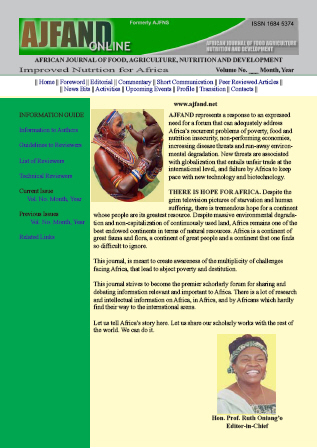
|
African Journal of Food, Agriculture, Nutrition and Development
Rural Outreach Program
ISSN: 1684-5358
EISSN: 1684-5358
Vol. 12, No. 6, 2012
|
 Bioline Code: nd12089
Bioline Code: nd12089
Full paper language: English
Document type: Research Article
Document available free of charge
|
|
|
African Journal of Food, Agriculture, Nutrition and Development, Vol. 12, No. 6, 2012
| en |
PROCESSING PINEAPPLE PULP INTO DIETARY FIBRE SUPPLEMENT
Ackom, NB & Tano-Debrah, K
Abstract
Several tonnes of conventionally consumed dietary fibre−containing fruit components are discarded as wastes in the processing of fruits into fruit juices, resulting in the loss of food nutrients and the increased production of organic waste. A study was done to investigate the processing of pineapple pulp waste from a processing plant, into a powdered product to be used as a dietary fibre supplement. The proximate composition and the functional properties of the raw material and final product were determined. The pasting characteristics or properties of wheat flour fortified with the product up to 20 % were also determined using a viscoamylograph. The wheat flour fortified at 10 % level was used to prepare cookies and muffins after which it was subject to a performance test. Proximate analysis of the product showed crude fibre content of about 30 %; crude protein: 8.5 %; crude fat: 1.5 %; total ash: 5.2 %, and ascorbic acid: 20 mg/100 g. The fat and water absorption capacities were 2.5 g/g and 2.0 g/g of product respectively. The foaming and gelation capacities of the product were found to be 2.8 % and 12 %, respectively. Changes in the pasting characteristics of the whole-wheat flour with the 10% level of fortification were not statistically significant. Acceptance levels of the cookies and muffins made from the composite flour were high and much preference was shown for samples from the fortified flour compared to samples from whole−wheat flour without fortification. This study demonstrated a potential way of harnessing pineapple pulp, a dietary fibre source, which is lost in fruit processing. This will improve the economic value to pineapple, which is widely cultivated in Ghana. It also demonstrated a way of increasing the dietary fibre content of some popular foods to help increase the fibre intake and health of the general population.
Keywords
dietary fibre, pineapple pulp, supplement
|
| |
© Copyright 2012 - African Journal of Food Agriculture, Nutrition and Development
Alternative site location: http://www.ajfand.net/
|
|
